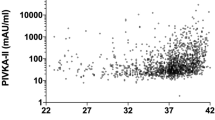Abstract
We report herein a case of early vitamin K deficiency bleeding (VKDB) in a neonate associated with maternal Crohn’s disease. A female neonate was born at 37 weeks’ gestation and weighed 2778 g. She developed broad purpura on her back on day 1. Laboratory data showed anemia, prolonged coagulation time and elevated protein induced by vitamin K absence or antagonist-II. Early VKDB has not been reported in a neonate born from mother with active Crohn’s disease. It is essential to give vitamin K selectively as soon as possible after birth to prevent early VKDB in neonates.
This is a preview of subscription content, access via your institution
Access options
Subscribe to this journal
Receive 12 print issues and online access
$259.00 per year
only $21.58 per issue
Buy this article
- Purchase on Springer Link
- Instant access to full article PDF
Prices may be subject to local taxes which are calculated during checkout

Similar content being viewed by others
References
Shearer MJ . Vitamin K deficiency bleeding (VKDB) in early infancy. Blood Rev 2009; 23 (2): 49–59.
Van Winckel M, De Bruyne R, Van De Velde S, Van Biervliet S . Vitamin K, and update for the paediatrician. Eur J Pediatr 2009; 168: 127–134.
Kuwabara A, Tanaka K, Tsugawa N . High prevalence of vitamin K and D deficiency and decreased BMD in inflammatory bowel disease. Osteoporos Int 2009; 20 (6): 935–942.
Nakajima S, Iijima H, Egawa S, Shinzaki S, Kondo J, Inoue T et al. Association of vitamin K deficiency with bone metabolism and clinical disease activity in inflammatory bowel disease. Nutrition 2011; 27: 1023–1028.
Schoon EJ, Müller MC, Vermeer C, Schurgers LJ, Brummer RJ, Stockbürgger RW . Low serum and bone vitamin K status in patients with longstanding Crohn’s disease: another pathogenetic factor of osteoporosis in Crohn’s disease? Gut 2001; 48: 473–477.
de Dombal FT, Softley A . IOIBD report no 1: Observer variation in calculating indices of severity and activity in Crohn’s disease. Gut 1987; 28: 474–481.
Shirahata A, Itoh S, Takahashi Y, Nishiguchi T, Matsuda Y . Revised recommendations for administration of vitamin K to prevent newborn and infant vitamin K deficiency bleeding (modified version). J Jpn Pediatr Soc 2011; 155 (3): 705–712.
Takahashi D, Shirahata A, Itoh S, Takahashi Y, Nishiguchi T, Matsuda Y . Vitamin K prophylaxis and late vitamin K deficiency bleeding in infants: fifth nationwide survey in Japan. Pediatr Int 2011; 53 (6): 897–901.
Wlddenshoven J, van Munster P, De Abreu R, Bosman H, van Lith T, van der Putten-van Meyel M et al. Four methods compared for measuring des-carboxy-prothrombin (PIVKA-II). Clin Chem 1987; 33 (11): 2074–2078.
Cornelissen EA, Kollee LA, De Abreu RA, van Baal JM, Motohara K, Verbruggen B et al. Effects of oral and intramuscular vitamin K prophylaxis on vitamin K1, PIVKA-II, and clotting factors in breast fed infants. Arch Dis Child 1992; 67: 1250–1254.
Liu J, Yuan E, Lee L . Gestational age-specific reference intervals for routine haemostatic assays during normal pregnancy. Clin Chim Acta 2012; 413: 258–261.
Cunningham FG et al. (eds) Williams Obstetrics 23rd edn. McGraw-Hill Medical: New York, NY, USA, 2012. pp116–117.
Nishiguchi T, Yamashita M, Maeda M, Matsuyama K, Kobayashi T, Kanayama N et al. Improvement of vitamin K status of breastfeeding infants with maternal supplement of vitamin K2 (MK40). Semin Thromb Hemost 2002; 28 (6): 533–538.
Sakai M, Yoneda S, Sasaki Y, Saito S . Maternal total parenteral nutrition and fetal subdural hematoma. Obstet Gynecol 2003; 101 (5 Pt 2): 1142–1144.
Dituri F, Buonocore G, Pietravalle A, Naddeo F, Cortesi M, Pasqualetti P et al. PIVKA-II plasma levels as markers of subclinical vitamin K deficiency in term infants. J Matern Fetal Neonatal Med 2012; 25 (9): 1660–1663.
Howe AM, Oakes DJ, Woodman PD, Prothrombin Webster WS . Prothrombin and PIVKA-II levels in cord blood from newborn exposed to anticonvulsants during pregnancy. Epilepsia 1999; 40 (7): 980–984.
Mijač DD, Janković GL, Jorga J, Krstić MN . Nutritional status in patients with active inflammatory bowel disease: Prevalence of malnutrition and methods for routine nutritional assessment. Eur J Intern Med 2010; 21: 315–319.
Lanfranchi GA, Brignola C, Campieri M, Bazzocchi G, Pasquali R, Bassein L et al. Assessment of nutritional status in Crohn's disease in remission or low activity. Hepatogastroenterology 1984; 31 (3): 129–132.
Hirose M, Akiyama M, Takakura K, Noda Y . Active Crohn disease with maternal vitamin K deficiency and fetal subdural hematoma. Obstet Gynecol 2001; 98 (5 Pt 2): 919–921.
Author information
Authors and Affiliations
Corresponding author
Ethics declarations
Competing interests
The authors declare no conflict of interest.
Rights and permissions
About this article
Cite this article
Ohishi, A., Nakashima, S., Ogata, T. et al. Early vitamin K deficiency bleeding in a neonate associated with maternal Crohn’s disease. J Perinatol 34, 636–639 (2014). https://doi.org/10.1038/jp.2014.64
Received:
Revised:
Accepted:
Published:
Issue Date:
DOI: https://doi.org/10.1038/jp.2014.64


